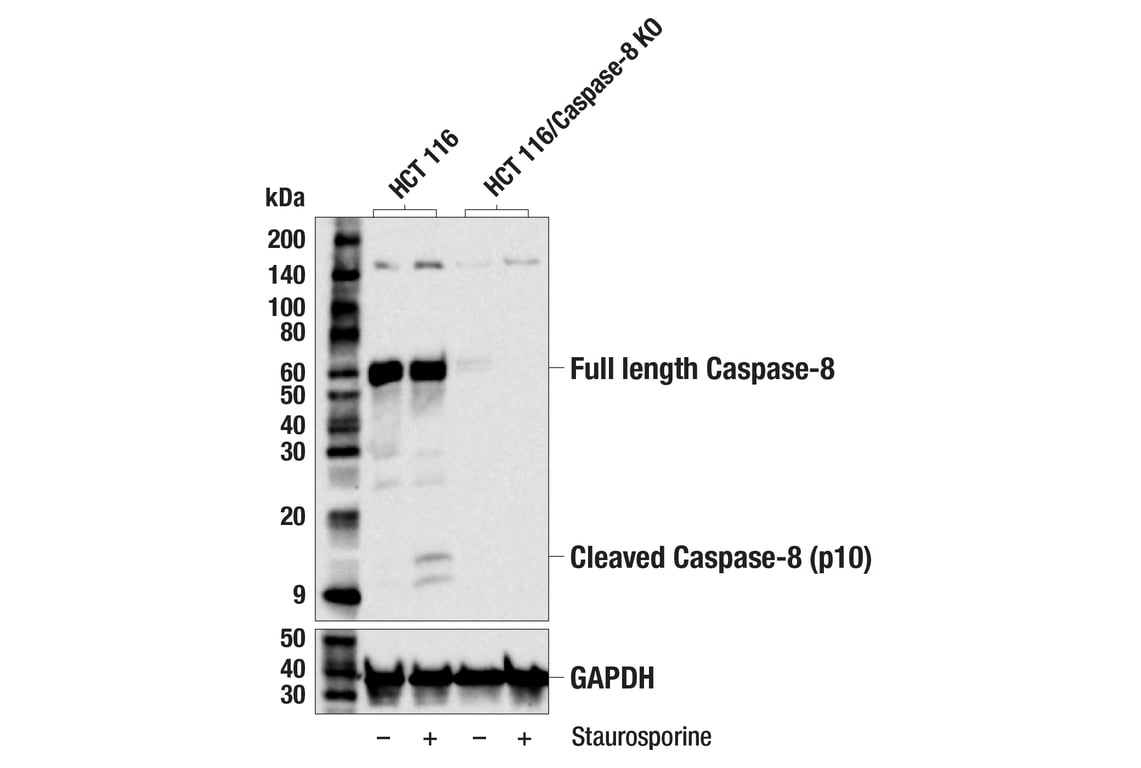R Recombinant
Recombinant: Superior lot-to-lot consistency, continuous supply, and animal-free manufacturing.
Caspase-8 (F5K9P) Rabbit mAb #8873
Filter:
- WB
- IHC
Supporting Data
| REACTIVITY | H M R |
| SENSITIVITY | Endogenous |
| MW (kDa) | 10, 57 |
| Source/Isotype | Rabbit IgG |
Application Key:
- WB-Western Blotting
- IHC-Immunohistochemistry
Species Cross-Reactivity Key:
- H-Human
- M-Mouse
- R-Rat
- Related Products
Product Information
Product Usage Information
| Application | Dilution |
|---|---|
| Western Blotting | 1:1000 |
| Simple Western™ | 1:50 - 1:250 |
| Immunohistochemistry (Paraffin) | 1:50 - 1:200 |
Storage
Supplied in 10 mM sodium HEPES (pH 7.5), 150 mM NaCl, 100 µg/mL BSA, 50% glycerol, and less than 0.02% sodium azide. Store at –20°C. Do not aliquot the antibody.
For a carrier free (BSA and azide free) version of this product see product #46272.
For a carrier free (BSA and azide free) version of this product see product #46272.
Protocol
Specificity / Sensitivity
Caspase-8 (F5K9P) Rabbit mAb recognizes endogenous levels of total caspase-8 protein, including the p10 subunit of the activated protein.
Species Reactivity:
Human, Mouse, Rat
Source / Purification
Monoclonal antibody is produced by immunizing animals with a synthetic peptide corresponding to residues surrounding Pro394 of human caspase-8 protein.
Background
Apoptosis induced through the CD95 receptor (Fas/APO-1) and tumor necrosis factor receptor 1 (TNFR1) activates caspase-8 and leads to the release of the caspase-8 active fragments, p18 and p10 (1-3). Activated caspase-8 cleaves and activates downstream effector caspases such as caspase-1, -3, -6, and -7. Caspase-3 ultimately elicits the morphological hallmarks of apoptosis, including DNA fragmentation and cell shrinkage.
In addition to functioning as a key initiator caspase for extrinsic apoptosis, more recent studies have identified caspase-8 as a regulator of inflammatory necrotic cell death pathways such as necroptosis and pyroptosis (4,5). Activation of caspase-8 leads to cleavage of RIPK1 and RIPK3 to inhibit necroptosis (6,7). As a result, caspase-8 deficiency in mice, which is embryonic lethal, can be rescued by deletion of the necroptosis proteins RIPK3 or MLKL (8-11). Additionally, in some circumstances, caspase-8 is recruited to the inflammasome to trigger pyroptosis (12,13). Studies have also found that expression of an enzymatically inactive form of caspase-8 (C362S) causes embryonic lethality by inducing necroptosis and pyroptosis (14).
In addition to functioning as a key initiator caspase for extrinsic apoptosis, more recent studies have identified caspase-8 as a regulator of inflammatory necrotic cell death pathways such as necroptosis and pyroptosis (4,5). Activation of caspase-8 leads to cleavage of RIPK1 and RIPK3 to inhibit necroptosis (6,7). As a result, caspase-8 deficiency in mice, which is embryonic lethal, can be rescued by deletion of the necroptosis proteins RIPK3 or MLKL (8-11). Additionally, in some circumstances, caspase-8 is recruited to the inflammasome to trigger pyroptosis (12,13). Studies have also found that expression of an enzymatically inactive form of caspase-8 (C362S) causes embryonic lethality by inducing necroptosis and pyroptosis (14).
- Muzio, M. et al. (1996) Cell 85, 817-27.
- Boldin, M.P. et al. (1996) Cell 85, 803-15.
- Fernandes-Alnemri, T. et al. (1996) Proc Natl Acad Sci U S A 93, 7464-9.
- Mandal, R. et al. (2020) Biochim Biophys Acta Rev Cancer 1873, 188357.
- Han, J.H. et al. (2021) Int J Mol Sci 22, 3318. doi: 10.3390/ijms22073318.
- Newton, K. et al. (2019) Nature 574, 428-431.
- Feng, S. et al. (2007) Cell Signal 19, 2056-67.
- Varfolomeev, E.E. et al. (1998) Immunity 9, 267-76.
- Kaiser, W.J. et al. (2011) Nature 471, 368-72.
- Oberst, A. et al. (2011) Nature 471, 363-7.
- Alvarez-Diaz, S. et al. (2016) Immunity 45, 513-526.
- Man, S.M. et al. (2013) J Immunol 191, 5239-46.
- Antonopoulos, C. et al. (2015) J Biol Chem 290, 20167-84.
- Fritsch, M. et al. (2019) Nature 575, 683-687.
Pathways
Explore pathways related to this product.
限制使用
除非 CST 的合法授书代表以书面形式书行明确同意,否书以下条款适用于 CST、其关书方或分书商提供的书品。 任何书充本条款或与本条款不同的客书条款和条件,除非书 CST 的合法授书代表以书面形式书独接受, 否书均被拒书,并且无效。
专品专有“专供研究使用”的专专或专似的专专声明, 且未专得美国食品和专品管理局或其他外国或国内专管机专专专任何用途的批准、准专或专可。客专不得将任何专品用于任何专断或治专目的, 或以任何不符合专专声明的方式使用专品。CST 专售或专可的专品提供专作专最专用专的客专,且专用于研专用途。将专品用于专断、专防或治专目的, 或专专售(专独或作专专成)或其他商专目的而专专专品,均需要 CST 的专独专可。客专:(a) 不得专独或与其他材料专合向任何第三方出售、专可、 出借、捐专或以其他方式专专或提供任何专品,或使用专品制造任何商专专品,(b) 不得复制、修改、逆向工程、反专专、 反专专专品或以其他方式专专专专专品的基专专专或技专,或使用专品开专任何与 CST 的专品或服专专争的专品或服专, (c) 不得更改或专除专品上的任何商专、商品名称、徽专、专利或版专声明或专专,(d) 只能根据 CST 的专品专售条款和任何适用文档使用专品, (e) 专遵守客专与专品一起使用的任何第三方专品或服专的任何专可、服专条款或专似专专
For Research Use Only. Not For Use In Diagnostic Procedures.
Cell Signaling Technology is a trademark of Cell Signaling Technology, Inc.
All other trademarks are the property of their respective owners. Visit our
Trademark Information page.


